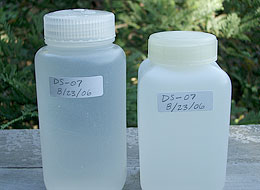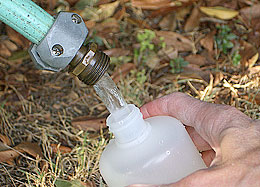- Home
- Learn about salinity
- Get to know your site
- Design a landscape
- Solve a problem
- Other information
Salinity Management Guide
Assessing the chemistry of irrigation water
How to collect a sample of water
The ideal sample is one that truly represents the irrigation water, remains free of foreign matter, and is delivered to the laboratory unchanged. Collecting such a sample involves numerous steps:
-
Find an analytical laboratory that conducts tests of irrigation water.
One way to locate an analytical laboratory is to ask a local University of California Cooperative Extension advisor who specializes in horticulture, or water quality, or both. For the name and telephone number of such an adviser, log onto the University of California Cooperative Extension Web site (http://ucanr.org/) and click the "County CE Offices" link. Click on your county on the map that appears. Then select the Cooperative Extension office nearest to you and click on the "Contact Us" link within the corresponding home page.
Another way is to look in your telephone directory's Yellow Pages and write down the names and numbers of the companies listed under "Laboratories–Analytical". Telephone laboratories that appear to conduct horticultural or agricultural testing of water and ask for details about the services they provide.
Once you've chosen a laboratory, contact them again before you collect your water sample(s). The laboratory's staff will provide the necessary forms and instructions and possibly a set of guidelines explaining how to sample. They may be able to provide sample containers, too.
-
If the laboratory doesn't provide containers, locate a suitable plastic bottle or jar with a tight-fitting lid. The container must be clean, as residue can skew results. If unsure of its cleanliness, first wash the bottle or jar thoroughly with soap and water and then rinse it three times with distilled water. A plastic container is preferable to a glass one, because glass is breakable and some types of glass can impart boron to the water. The container should be large enough to hold the required amount of water. Laboratories usually need about 1 quart.
Also locate labels of good quality and either a pencil that won't smear or a pen with waterproof ink. Test the labels with the pencil or pen before going into the field, to make sure they are compatible and that the labels will securely adhere to the container.
- At the landscape's site, locate a running hose, operating sprinkler, or other operating point of emission. Allow the water to run freely for a minute. Before filling the container, rinse the container two to three times with the water to be sampled. All of this helps to ensure a more representative sample.
- Once filled, close the container tightly and test it for leaks by turning it upside down. If it leaks, recap it carefully and test again. If it still leaks, use a different container.
- Label the container with pertinent information. This could include the date of sampling, the time, the location, the number of the sample, and the name of the sampler.
If the sample won't be delivered immediately to the laboratory, refrigerate it until you are ready to arrange for its transportation.
- Inform the laboratory's staff about precisely what you want measured. A routine panel of tests for water may or may not cover what you need. Find out if the laboratory can analyze the needed parameters.
To monitor the salinity of a landscape over time — often a good idea when the landscape is irrigated with recycled water — collect samples at least once a year. If the chemistry of the landscape's irrigation water is likely to vary considerably during the year, then sample more often, such as monthly. Doing so helps to uncover any variations that arise over time. If possible, coordinate closely with the manager of the facility providing the water, to keep abreast of any changes in the water's quality.
If more than one source of water is used for irrigation, either simultaneously or separately, samples from each source and any blend should be obtained and analyzed.
| « Previous page | Next page » |

